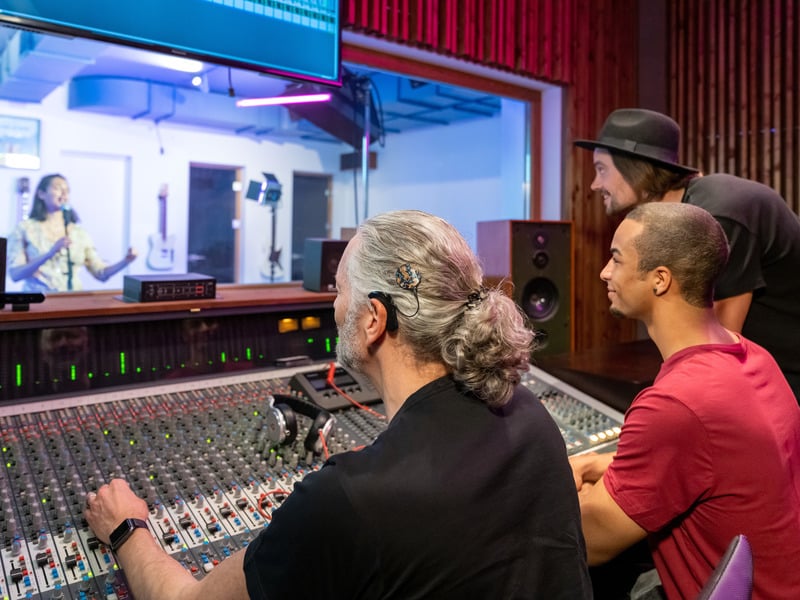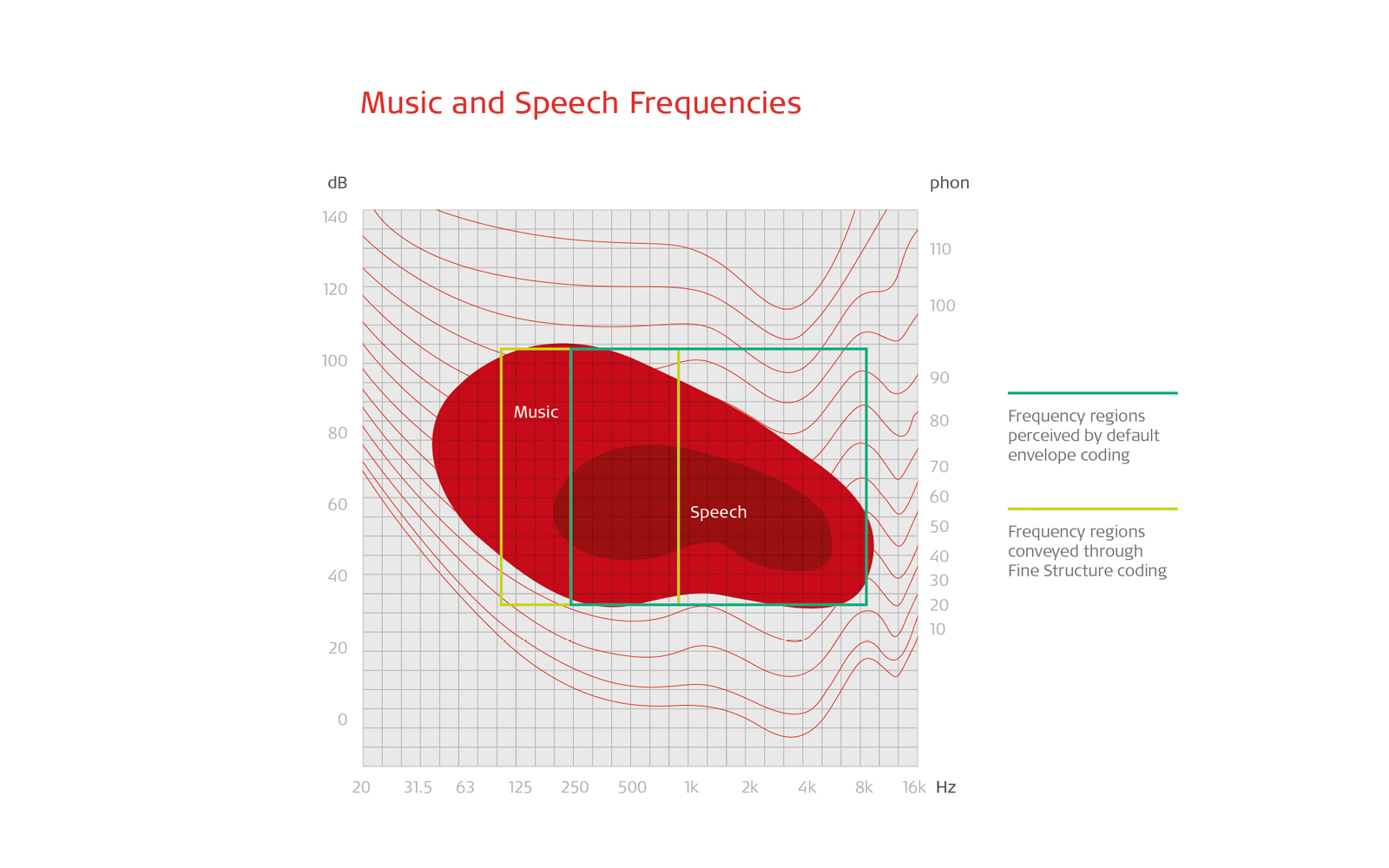
MED-EL
Published Jun 07, 2023
Beyond Speech: How MED-EL Cochlear Implants Handle the Complexity of Music
Understanding music is a complex process. MED-EL's cochlear implant technology makes it possible for users to perceive and appreciate music.

Understanding speech is a complex process. But cochlear implants have been enabling people with severe-to-profound sensorineural hearing loss to understand speech for decades.
These devices are now typically called audio processors, but why change the name? Today’s processors not only allow cochlear implant recipients to hear and understand speech, but they also make it possible to perceive and appreciate more complex sounds: music.
To comprehend these more complex sounds, CI users need advanced audio processing and innovative implant technology that brings them closer to natural hearing. There are many aspects of music that make it more intricate than speech. Although sound perception varies between users depending on factors such as duration and cause of deafness, MED-EL has developed technology to handle music’s complexity and provide CI users with the opportunity to enjoy music more.
Frequency and Volume
The range of frequencies in music is usually much wider than in speech. The frequencies produced by instruments such as the tuba, for example, are much deeper than the lowest human voice. And the high-pitched voice of a child is not nearly as high as the treble sounds of a piccolo, for example. Speech ranges from about 125-8000 Hz.
To perceive a wide range of frequencies in a manner that is as undistorted as possible, the cochlear implant electrode array needs to cover as much of the length of the cochlea as possible. MED-EL has developed the largest portfolio of electrode arrays available on the market. Cochleae vary in size, and by selecting the electrode array that best corresponds to an individual’s cochlear duct length, CI recipients have access to lower frequencies stimulated in the apical region of the cochlea, significantly improving music appreciation. [1] MED-EL audio processors can pick up frequencies that range from 70-8500 Hz.
Like frequency, the range of volume in music that people can enjoy listening to is also much wider than in speech, especially in orchestral music. When all the musicians in an orchestra play fortissimo together, it can be very intense. (Rowdy sports fans in a stadium can be even louder, but that’s a sound most listeners try to block out rather than actively listen to.) And dynamic contrast as well as the build-up and diminishing of tension are essential in conveying emotions in music; a loud, frenetic section could transition into a mournful and delicate pianissimo solo.
Advanced front-end processing with programs designed specifically for music enables audio processors to transmit a wide dynamic range with optimal compression. This preserves loudness cues sufficiently, enabling CI recipients to perceive the dynamic complexity of music without too much modulation depth distortion. [2]
The range of frequency and volume required for speech perception can be illustrated in the “speech banana” audiogram shown below. Also indicated on the audiogram is a larger bubble that represents the volume and frequency ranges required for complete music perception. This visualization makes it clear that cochlear implant technology that is sufficient for speech perception with regard to pitch and volume may not be adequate for music enjoyment.
Music and Speech Frequencies

Speech in Quiet or Noise vs. Full Tapestry of Sound
Understanding speech in a variety of hearing situations is very important for communication. From speech in quiet to speech in noise, advanced audio processing technologies can adjust to different levels of background noise and focus in on speaking voices. For speech in quiet, as few as four spectral channels may be enough. Music, however, consists of a tapestry of sound in which many layers come together to form one song, therefore requiring more channels. [3]
For optimal music appreciation, CI users must perceive all layers of sound, not just one instrument. MED-EL electrode arrays consist of twelve electrodes, but the creation of up to 250 pitches along the entire electrode array makes it possible to transmit a continuum of frequencies. This makes sound richer and more natural.
Fine Structure and Envelope of Sound for Perception of Timbre
Timbre is a quality of musical sound that plays an important role in distinguishing between instruments. One important aspect of timbre is the fine structure of sound. Temporal fine structure is the more rapidly oscillating carrier of sound that is contained within the envelope of sound, the slower temporal cues.
Most cochlear implant technology only uses the envelope of sound in its sound coding strategies. But MED-EL’s FineHearing technology uses rate-matched coding to stimulate the apical portion of the cochlea in sync with the fine structure of sound. This combination of rate-matched and place-matched coding improves timbre perception and brings MED-EL CI recipients closer to natural hearing. [4]
Fine Structure vs. Envelope of Sound

Additional Benefits for Speech Understanding
In tonal languages, such as Mandarin and many other Asian and African languages, perception of pitch plays a particularly important role. A slight difference in tone can result in a different word with a completely different meaning. CI users who are learning to speak a tonal language such as Mandarin can benefit from MED-EL technology, which reproduces pitch more accurately. [5]
MED-EL technology that makes music perception and appreciation possible also brings users closer to natural hearing. Although auditory plasticity makes it possible to compensate for pitch-place mismatch to some extent, when the mismatch is too great, users may not be able to adapt to it completely. [6] So the closer the electrodes’ frequencies match the cochlea’s natural tonotopicity, the faster the rehabilitation process may go and the less of a workout it is for the brain to correctly perceive the frequencies of speech and other sounds.
How Well Can Cochlear Implant Users Perceive Music?
Despite advances in cochlear implant technology, many myths remain about how a cochlear implant sounds, especially when it comes to music. In a recent study, cochlear implant recipients used the music training app Meludia to improve music skills such as interval and chord perception. The results of the study showed that many MED-EL CI users can perceive the intricacies of music far better than commonly believed.
Previous studies had shown that CI recipients could typically only perceive a three-semitone difference in pitch (for example, F vs. G#). [7] But with MED-EL cochlear implants, 80% of recipients who participated in the Meludia study were able to complete lessons that involved distinguishing between a single semitone (for example, F vs. F#). And with additional music training, their abilities may improve even further. [8]
Music and Quality of Life
Music perception should not be thought of as a mere added bonus for CI users; music and other complex sounds are integral parts of everyday life. Through music we form meaningful connections to other people and the world around us. Music improves quality of life significantly. And by improving music perception for CI users, we also bring them closer to natural hearing.
References
- Landwehr et al. Effects of various electrode configurations on music perception, intonation and speaker gender identification. Cochlear Implants Int. 2014 Jan; 15(1): 27-35.
- Gilbert, M., Deroche, M. L. D., Jiradejvong, P., Barrett, K. C., & Limb, C. J. (2021). Cochlear Implant Compression Optimization for Musical Sound Quality in MED-EL Users. Ear And Hearing, 43(3), 862–873. https://doi.org/10.1097/aud.0000000000001145
- Limb, C. J., & Roy, A. T. (2014). Technological, biological, and acoustical constraints to music perception in cochlear implant users. Hearing Research, 308, 13–26. https://doi.org/10.1016/j.heares.2013.04.009
- Müller et al. Clinical trial results with the MED-EL fine structure processing coding strategy in experienced cochlear implant users. ORL J Otorhinolaryngol Relat Spec. 2012; 74(4): 185-98.
- Gao, Z., Wang, S., Yang, H. G., Xia, F., Shang, Y., Wang, B., Tian, X., Li, Y., Wei, X., Shu, Z. M., & Chiusso, F. (2022). Cochlear Implantation in Young Mandarin-Speaking Children: One Year After First Fitting. Otology & Neurotology, 43(6), e645–e650. https://doi.org/10.1097/mao.0000000000003555
- Svirsky, M. A., Fitzgerald, M. B., Sagi, E., & Glassman, E. K. (2015). Bilateral cochlear implants with large asymmetries in electrode insertion depth: implications for the study of auditory Acta Oto-laryngologica, 135(4), 354-363. https://doi.org/10.3109/00016489.2014.1002052
- Kang, , Nimmons, G.L., Drennan, W., Longnion, J., Ruffin, C., Nie, K., et al. 2009. Development and validation of the university of Washington clinical assessment of music perception test. Ear & Hearing, 30(4): 411–418. doi:https://doi.org/10.1097/AUD.0b013e3181a61bc0.
- Boyer, J., & Stohl, J. (2022). MELUDIA – Online music training for cochlear implant users. Cochlear Implants International, 23(5), 257–269. https://doi.org/10.1080/14670100.2022.2069313
References

MED-EL
Was this article helpful?
Thanks for your feedback.
Sign up for newsletter below for more.
Thanks for your feedback.
Please leave your message below.
CTA Form Success Message
Send us a message
Field is required
John Doe
Field is required
name@mail.com
Field is required
What do you think?
The content on this website is for general informational purposes only and should not be taken as medical advice. Please contact your doctor or hearing specialist to learn what type of hearing solution is suitable for your specific needs. Not all products, features, or indications shown are approved in all countries.
Christian Harris
May 05, 2024
I am a musician with cochlear 8 implants in both ears. I am looking for the best music program for the Cochlear implant 8 and this is what I have now. 1. Deactivate E21 2. Increase maxima to max amount 3. Omnidirectional, SCAN off, ADRO & ASC on, noise reduction and wind noise reduction off. 4. Maximize dynamic range (or, if not possible, then slightly reduce loudness growth) This works good for letting me play my guitar or piano with the music in the background but it has a loud noise that I need lowered and the voices raised. Any help I could get from you would be awesome! Thank you,
MED-EL
May 06, 2024
Christian, thank you for your comment. If you have Nucleus 8 sound processor by Cochlear, we would recommend getting in touch with that manufacturer's local team or your clinician as they will be best equipped to assist you directly with the program that would work best for needs. Kind Regards

MED-EL

MED-EL

.png)



Conversation
1 Comment